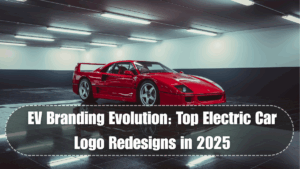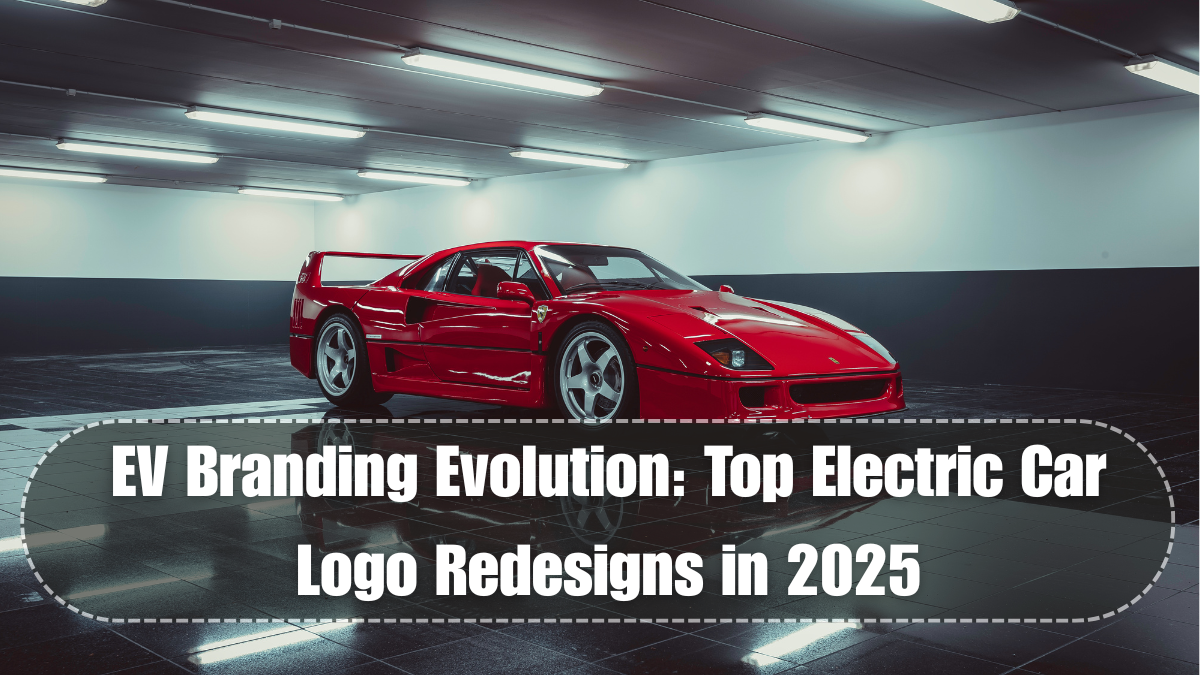The electric vehicle (EV) revolution isn’t just transforming how we drive—it’s also reshaping how we perceive brands. In 2025, EV branding and visual identity have entered a bold new era, where logos, typefaces, and visual systems are being redesigned to match the sleek, sustainable, and tech-driven nature of modern mobility.
From subtle tweaks in typography to complete overhauls of classic logos, automakers are making significant moves to reflect their EV ambitions. These changes aren’t just cosmetic—they represent a deeper shift in design language, consumer psychology, and the digital-first world of vehicles. Across the globe, both heritage automakers and EV startups are redefining how their EV brand design connects with a new generation of eco-conscious and tech-savvy buyers.

Why are auto companies rebranding in 2025?
The rise of electric vehicles has forced automakers to rethink not only their engineering but also their marketing and brand identity. In 2025, auto logo 2025 trends show that companies are shedding the aggressive, industrial look of the past in favor of minimal, futuristic, and flat designs.
Here’s why rebranding has become essential:
-
Digital integration: With dashboards, apps, and websites now key touchpoints, logos need to be screen-friendly and scalable.
-
Sustainability messaging: Flat, clean designs resonate more with the green-conscious consumer base.
-
Market repositioning: EV-focused brands want to differentiate from their internal combustion engine (ICE) past.
-
Globalization: Simplified identity systems appeal to a broader global audience across languages and cultures.
This push for fresh EV branding and visual identity is as much about perception as it is about purpose—conveying innovation, speed, and responsibility through every pixel and line.
Notable EV brand design transformations
Several big-name automakers have already unveiled revamped identities that align with EV brand design principles. Below are a few of the most impactful updates of 2025:
-
Volkswagen: Shifted to a flat 2D logo in clean blue hues—signifying electric power and minimalism.
-
Kia: Introduced an edgy, connected-letter logo that symbolizes digital mobility.
-
Tata Motors: Adopted a refined sans-serif typeface and silver-toned badge that reflects a future-ready brand.
-
Mahindra: Unveiled a modern trident-like “Twin Peaks” logo to define its EV sub-brand identity.
-
Renault: Updated its diamond logo to a sharper, geometric flat design suitable for digital EV dashboards.
All these changes in auto logo 2025 trends are part of larger, comprehensive identity updates—including new brand colors, sound signatures for EVs, redesigned dealerships, and UI themes in apps.
Key trends in EV branding and visual identity in 2025
Let’s break down the specific design directions shaping EV branding and visual identity this year:
| Trend | Description | Example |
|---|---|---|
| Flat & Minimalist Logos | 2D, outline-based logos optimized for digital screens | VW, Nissan, GM |
| Futuristic Typography | Use of sleek, geometric, or custom fonts to imply tech & motion | Kia, Lucid Motors |
| Monochrome or Dual-Tone Palettes | Clean, modern palettes (e.g., black-white, silver-blue) | Mercedes EQ, Hyundai Ioniq |
| Dynamic Animations | Logo animations used in apps, screens, and EV dashboards | Polestar, Tesla |
| Sound Signatures | Unique digital sounds to define brand presence in EVs | BMW, Audi |
| Sub-Brand Identity Systems | New logos for EV-only product lines within traditional automakers | Mahindra BE, Hyundai Ioniq |
These branding strategies are designed to build strong emotional connections in a world where customers experience brands first through screens and interfaces before even test-driving a vehicle.
The power of visual identity in the EV era
In a market flooded with EV startups and tech-forward vehicles, EV branding and visual identity have become critical differentiators. Consumers are no longer swayed by horsepower or engine roars; instead, they look for modern aesthetics, UI coherence, and design innovation.
Key elements driving identity update strategies in EV companies include:
-
Cross-platform consistency: From car badges to app icons, a brand must feel consistent and cohesive.
-
Visual storytelling: Logos and identity systems now often convey a narrative—like sustainability, speed, or futuristic living.
-
Localization: As EVs expand globally, visual identity systems are also being adapted to regional aesthetics.
These branding components are now being crafted in tandem with UI/UX designers, not just graphic designers—ensuring that the logo doesn’t just look good, but behaves well within EV dashboards, infotainment systems, and mobile apps.
FAQs
Why are so many EV companies changing their logos?
To align with modern digital design standards and communicate their shift toward sustainability and tech, EV makers are revamping their EV branding and visual identity.
What makes EV brand design different from traditional auto design?
EV brand design focuses more on minimalism, screen readability, and futuristic themes, as opposed to the bold and metallic styles of combustion-era vehicles.
How does logo design impact EV buyer decisions?
Logos influence first impressions. Clean, modern designs reflect innovation and trust—critical for tech-driven consumers entering the EV space.
Are animated logos becoming standard in EV branding?
Yes, animated logos now appear in car startup screens, apps, and websites, becoming a growing part of the identity update strategy.
Which Indian brands are leading in EV visual identity updates?
Tata and Mahindra have both taken bold steps in 2025 to reimagine their branding for their EV offerings.
Conclusion
The evolution of EV branding and visual identity in 2025 reflects a deeper transformation in how automotive brands present themselves to the world. Clean, intelligent, and screen-first designs are becoming the norm as automakers align their visual identity with the ethos of electric mobility. With EV brand design now playing a crucial role in shaping consumer trust and product experience, the auto logo 2025 trends are more than rebranding—they’re a signal of the industry’s commitment to the future. Whether it’s a glowing badge on a dashboard or an app icon on your phone, the face of mobility is getting a futuristic facelift—and it’s here to stay.
